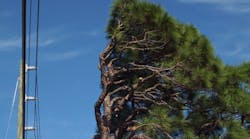Last month’s article concluded with: Given the public role in limiting the methodology and extent to which utilities may address the risks associated with an overhead electrical system, we have a societal issue.
How do we arrive at a general acceptance of this?
Perhaps utilities need to take a page from the pharmaceutical industry. I’m sure you’ve seen the television ads for drugs which after touting the benefits conclude with a litany of possible adverse reactions.
Utilities seem averse to talking about negative outcomes. When I was a utility forester, one of our Public Affairs staff asked me, “What is the biggest impediment to attaining the needed clearance?” My answer was that the public did not recognize the extent of the safety hazard, the potential for maiming or even death. Nor did the public understand the reliability implications of trees in close proximity to power lines. She then asked, given our success with landowners, what we had done to address the issue. (We were removing 75% of the trees we touched and the VM program had a 98% customer satisfaction rating.) She was somewhat aghast when I told her our consenters were pointing out that should a child climbing the tree make contact with the power line it could be fatal, with best-case outcome being the loss of appendages such as fingers, toes, hands, feet. We weren’t doing this simply to attain clearance. We were doing it to educate the customer, who was required to provide a signed consent for the work so that they could make a reasoned choice about their risk exposure and to limit the liability of the company.
In other words, by being forthright with the customer, not only were we educating but we were co-opting the customer into solving with us the issues of safety, reliability and future costs. Did they resent us for providing the facts? No, the customer satisfaction rating distinctly communicated they appreciated being involved in the decision making process.
Present the Facts
If we are to gain acceptance that the risk trees pose to the safety and reliability of the overhead electric system is a societal issue, we will do so by presenting absolutely arresting, compelling facts about the residual risk. The facts will need to be so compelling that they entirely deflate the fantasy that you can have tall trees growing near and over power lines without any or minimal reliability consequences. Doing so will require a shift in thinking within utilities. I think it’s pretty universal that utilities want to be perceived as being “green.” But the hard reality is that from a utility perspective, trees represent a liability in both the legal and financial sense. While communities and individuals view trees as assets, to a utility, trees represent a liability. Trees can impair utility assets but have no capacity to increase the value of those assets.
The tolerance of any trees that have the capacity to interrupt electrical service needs to be seen not as utility inaction but the result of a decision to satisfy societal needs for aesthetics. That is not to trivialize what the public wants. There have been studies that show the amount of green space affects the psychological and emotional health of communities and can at times be measured in crime rates. For example, it needs to be clear to both the regulator and the public that any electric utility located where damaging ice storms are not unforeseen (which is any area running from the Canadian Maritimes south to northern Florida and west to Oklahoma, plus the Pacific northwest), would from an asset management perspective not tolerate any branches overhanging conductors. The thousands upon thousands of miles of line with branch overhangs exist solely as an accommodation to the public desire for trees.
Make the Risks Explicit
Utilities deal with myriad contracts and are active participants in their structuring. However, in terms of the social contract, I believe they have been passive and consequently it is defined by the regulators and the ever-evolving expectations of the public and politicians. It’s entirely fitting that the expectations arise from the public, the customer. However, when utilities fail to make explicit the reliability and safety risks associated with trees in proximity to power lines, the customer is not positioned to make an informed decision and consequently, expectations for system performance tend to be unrealistic, leading to frustration for all parties.
On the other hand, a fully informed public choosing the status quo or increasing greenscape, recognizing the associated risks will feel and direct much less hostility toward the utility should an event trigger the realization of the forecast degree of damage. If the public is asking for information about power restoration rather than angrily demanding politicians rectify the situation, then the heat on utility executives will also be lowered.


